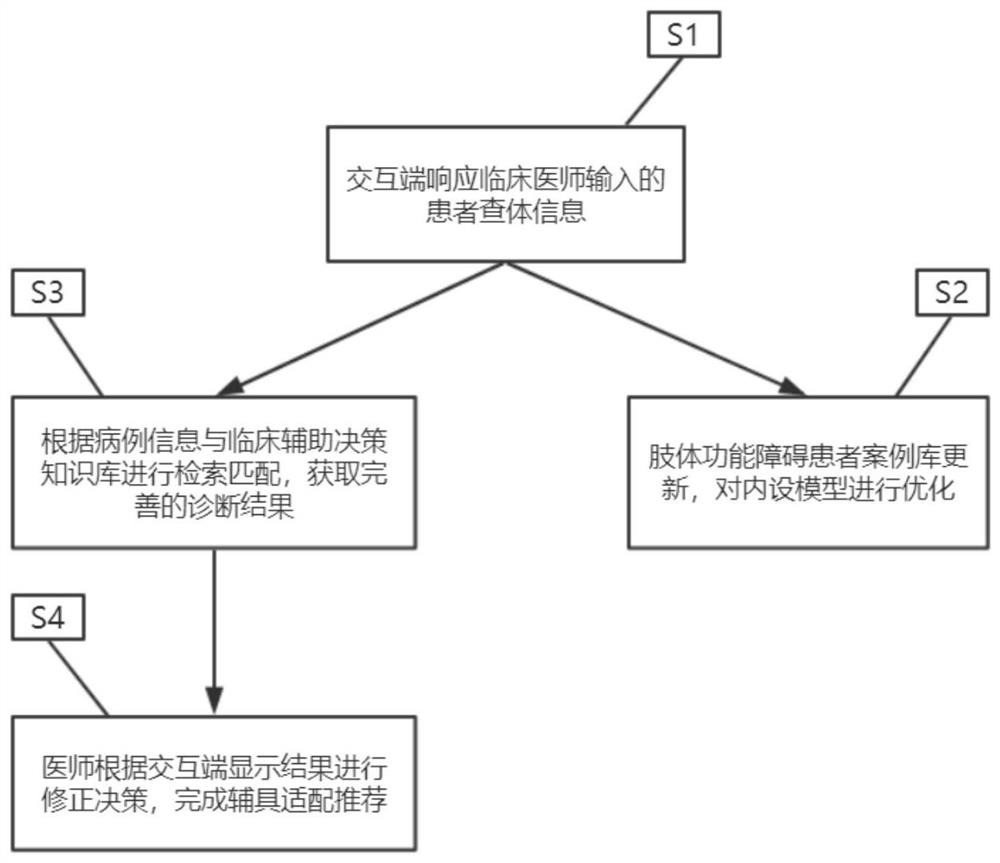Decision support system for limb dysfunction patient rehabilitation assistive device adaptation
A decision support system and dysfunctional technology, applied in the field of decision support systems, can solve the problems of low adaptation rate of rehabilitation aids, weak awareness of rehabilitation, and low adaptation efficiency, so as to improve efficiency, reduce workload, and improve fitness. The effect of ratio
- Summary
- Abstract
- Description
- Claims
- Application Information
AI Technical Summary
Problems solved by technology
Method used
Image
Examples
Embodiment 1
[0032] In order to illustrate the auxiliary decision-making system for the adaptation of rehabilitation aids for patients with limb dysfunction designed in the present invention, figure 1 It shows that the system includes an interactive terminal A and an arithmetic unit terminal B. Among them, the interactive terminal A includes an input module A1, a processor A2, a display module A3, and a sending module A4; the computing terminal B includes a feedback module B1, an analysis module B2, and a clinical auxiliary decision-making knowledge base B3.
[0033] Interaction terminal A is used for clinicians to interact with the system, input patient information and upload it to calculator terminal B for processing, and interaction terminal A can display corresponding output results; among them,
[0034] Input module A1: used to enter basic information and clinical examination information of patients;
[0035] Processor A2: used to process the instructions of each module of the intera...
Embodiment 2
[0046] like figure 2 As shown, a schematic flow chart of an auxiliary decision-making method for the adaptation of rehabilitation aids for patients with limb dysfunction according to the present invention is figure 1 Further illustration of the system shown. Including the following steps:
[0047] S1. The interactive terminal A responds to the patient's physical examination information input by the clinician.
[0048] The clinician enters the basic information of the patient in the input module A1 of the interactive terminal A, as well as some medical diagnosis information, including: limb dysfunction, fitting purpose, living environment and space, abnormal muscle strength and other information.
[0049] S2. Enter the patient's basic information and physical examination information into the case database of patients with limb dysfunction for updating, and optimize the built-in model algorithm.
[0050] In one embodiment of the present invention, after the clinician enters ...
Embodiment 3
[0061] like Figure 4 As shown, the present invention provides an auxiliary decision support system 300 for the adaptation of rehabilitation aids for patients with limb dysfunction, including an information collection unit 301 , an aid fitting plan formation unit 302 and a decision confirmation unit 303 .
[0062] Wherein the information collection unit 301 such as Figure 5 As shown, it is used to collect and enter the basic information of the patient to be retrieved and matched and the physical examination information, which is convenient for further retrieval and matching in the clinical auxiliary decision-making knowledge base, to find out the past cases most similar to this case, and to make targeted decisions. Assistive device adaptation program. First, enter the basic information and physical examination information of the patient, including but not limited to limb dysfunction, adaptation purpose, living environment and space, abnormal muscle strength, etc. The doctor...
PUM
 Login to View More
Login to View More Abstract
Description
Claims
Application Information
 Login to View More
Login to View More - R&D
- Intellectual Property
- Life Sciences
- Materials
- Tech Scout
- Unparalleled Data Quality
- Higher Quality Content
- 60% Fewer Hallucinations
Browse by: Latest US Patents, China's latest patents, Technical Efficacy Thesaurus, Application Domain, Technology Topic, Popular Technical Reports.
© 2025 PatSnap. All rights reserved.Legal|Privacy policy|Modern Slavery Act Transparency Statement|Sitemap|About US| Contact US: help@patsnap.com



